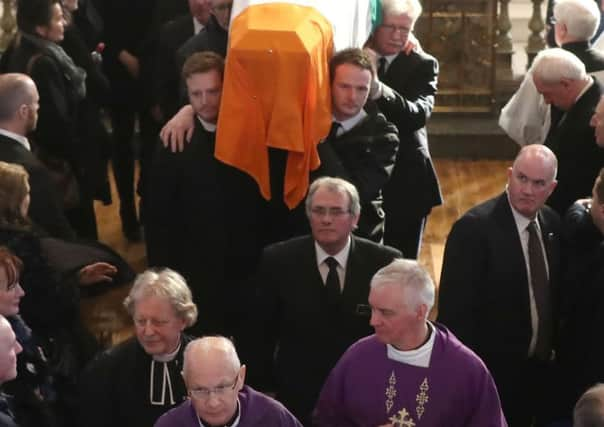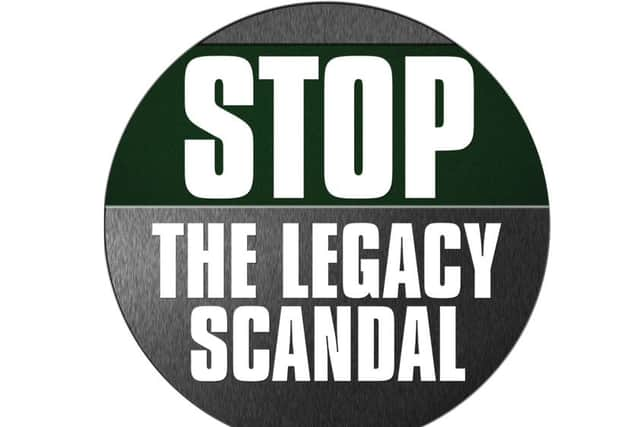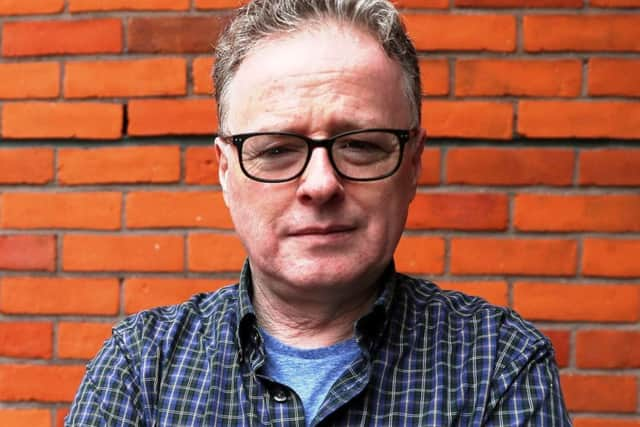Legacy Scandal: '˜Some of us in the IRA concluded back in the 1970s that violence was wrong'


How have we ended up in a situation following a peace process and an agreement in which half of the political establishment in Northern Ireland expresses the belief that the murders of approximately 1,700 men, women and children by the Provisional IRA were wholly legitimate, necessary and to be celebrated for ever into the future?
How is it possible in a normal democracy to regard not alone the supporters and apologists for mass murder but some of the actual practitioners of those murders as worthy to sit in government not only without a shred of guilt, remorse, repentance or shame but in actual fact with brazen arrogance, sanctimonious dictates and a total absence of humility?
Advertisement
Hide AdAdvertisement
Hide AdThis is the same IRA entity which — under orders from the three governments — mostly dissolved its ranks (if not its overarching secretive Army Council) and disposed of its illegal weapons, if not its ill-gotten monies which did not seem to count in any of the disposal requirements, such as petrodollars received from murderous Libyan dictator Muammar Gadaffi (charitable international donor of Semtex and AK47s with whom the IRA struck a dirty deal to wage more proxy-terror than before against Britain – links with dictators probably not mentioned on IRA tours) and the last minute Northern Bank mi££ions.


At what point in the process of shamefacedly dissolving its fighters and weapons from history did it go off message and begin boasting about its ‘victory’, its human rights concern and its legitimate campaign of mass murder?
The primary problem with the Sinn Fein/IRA entity is its massive lies and we should start by examining the biggest lie promoted by Sinn Fein/IRA, the lie of ‘the necessary armed struggle’.
Throughout the period of social and political unrest in the late 1960s and early 1970s, the Northern Ireland Civil Rights Association — which contained many Protestant advocates — was managing to achieve reforms via activism, marches and peaceful civil disobedience.
Advertisement
Hide AdAdvertisement
Hide AdOn April 23 1969 the Stormont parliament voted to introduce one of NICRA’s key demands, ‘universal adult suffrage’ (one person, one vote) in local government elections.


The IRA had previously declared an armed ‘border campaign’ beginning in 1956 which failed spectacularly for lack of popular support.
It was belatedly called off in 1962 and was followed by an amnesty shortly afterwards based on assurances that it would disappear off stage.
It could not believe its luck when housing activists in 1966 and the later peaceful civil rights organisation began in 1968 to militate citizens onto the streets in large numbers.
Advertisement
Hide AdAdvertisement
Hide AdThe early photographs show depleted IRA members at the forefront of the protests, marches and riots — Sean Keenan, Johnny White, Billy McKee, Joe McCann to mention only a few.
The IRA’s aim was to infiltrate, dominate and exploit any movement likely to progress its desire to destroy Northern Ireland by disorder and force of arms and where it could not do so — such as with the early Peace People movement — it resorted to intimidation. (Margaret Doherty, a leading Peace People person in the Bogside, was forced to move out of her home along with her family by the IRA. Even John Hume’s home in Westend Park was regularly attacked by IRA supporters if not members.)
In 1969 the IRA throughout the island of Ireland split over reform of Northern Ireland (the Official IRA or ‘Stickies’ plan) or bloody revolution (the Provos’ plan).
Following the birth of the Provisional IRA, a Londoner, John Stephenson — whose mother was an East Belfast Protestant and whose father was English – became its first Chief of Staff under the Irish spelling of his name, Sean MacStiofain.
Advertisement
Hide AdAdvertisement
Hide AdHe left his job as a financial organiser for Conradh na Gaeilge (The Gaelic League) Irish language organisation to lead the first and most bloody IRA campaign until he was ousted from his position in November 1972. (In the 1980s and 1990s, Stephenson — the former IRA Chief of Staff — returned to working for Conradh na Gaeilge and in its centenary year, 1993, when he was the person of honour on a platform in O’Connell Street, Dublin, he did not appear to note the irony of its founder, Protestant Douglas Hyde, having resigned from it in 1915 in protest at its infiltration by armed struggle proponents such as him. None of these historical notes are intended to highlight connections between IRA personnel and Irish language organisations.)
Stephenson did publicly call on the Provos to give up the armed struggle in 1983.
Provo GHQ Quartermaster Jack McCabe was killed in a premature explosion in a Dublin bomb factory in 1971 attempting to make black powder bombs for ‘the north’.
Weapons from across Ireland were being funnelled northwards to ‘protect the nationalist minority’ — IRAspeak for a new armed struggle regardless of the views of northern nationalists.
Advertisement
Hide AdAdvertisement
Hide AdSome elements of the Irish government and Irish army — Haughey, Boland, Blaney and Captain James Kelly — were allegedly willing to see larger arms’ shipments going northwards and had notions of influencing NICRA.
The northern nationalist community offered opportunities for a proxy-war militated by interests unconnected with its actual needs or desires.
A primary aim of the IRA and some other groups was to dominate or eradicate the pacifist Northern Ireland Civil Rights Association to prevent it obstructing its new armed campaign.
The British Army and the IRA were to supply the occasion to render NICRA obsolete — Bloody Sunday.
Advertisement
Hide AdAdvertisement
Hide AdWhen I wrote “The Volunteer — A Former IRA Man’s True Story” for HarperCollins back in 1991 (not published until 1993) — it was the first book to have an entire chapter dedicated to ‘Bloody Sunday’.
Even back then, I began the narrative of Bloody Sunday with the previous Thursday’s events.
In full knowledge of the imminent civil rights’ march seventy-two hours later on these same streets, the Derry Brigade of the IRA set an ambush on Creggan Hill and Helen Street just below Rosemount police barracks — using the adjacent cover of the so-called ‘no go area’ — and when a police car appeared it was riddled by gunfire which included a Thompson submachine gun.
Two members of the RUC were murdered — Sergeant Peter Gilgunn, 26, a Catholic, and Constable David Montgomery, 20, a Protestant, and a third was seriously injured.
Advertisement
Hide AdAdvertisement
Hide AdIt is almost certain that Martin McGuinness was one of the shooters. If this was not a blatant IRA attempt to militarise the imminent civil rights’ march, nothing was.
On Bloody Sunday itself, and in the aftermath of the police officers’ blood spilled on Creggan Hill on Thursday, IRA volunteers — including Martin McGuinness — had broken into Duffy’s bookies on Chamberlain Street/High Street with nail bombs and at least one Thompson sub-machine gun with the obvious intention of attacking the soldiers at barricades below in William Street while the march was in progress.
Martin McGuinness later determined never to tell the truth of the matter either to the Saville inquiry or to posterity.
The notion that the families of the Bloody Sunday victims deserved the whole truth and nothing but the truth held no sway with men who had sworn to obey the IRA over and above everything else in life.
Advertisement
Hide AdAdvertisement
Hide AdIn the late 1960s and early 1970s, far from needing anyone to murder and bomb for them, northern Catholics were very well served by the then decreasing Nationalist Party led by Eddie McAteer and by the increasing SDLP led by Gerry Fitt, John Hume, Paddy Devlin, Seamus Mallon and Austin Currie.
The vast and overwhelming majority of nationalists repeatedly voted for these democratic and constitutional parties who regularly called upon the IRA to cease entirely its unwanted and unnecessary armed struggle.
The IRA’s secondary aim was to divorce young people and as much of the nationalist population as possible from the sway of the Catholic church which regularly condemned IRA violence and called upon the IRA to desist.
Fr Edward Daly, the priest who famously waved a white handkerchief on Bloody Sunday, was appointed Bishop of Derry in 1974.
He recalled in his book, A Troubled See:
Advertisement
Hide AdAdvertisement
Hide AdIn September 1974, I was called upon to officiate at my first funeral of a victim of violence since my appointment as Bishop of Derry ... Judge Rory Conaghan was a member of a distinguished Derry family and a man of great intelligence, integrity and faith. He was a personal friend of mine and widely admired in both communities. He was murdered by a Provisional IRA gunman posing as a postman at his home in Belfast on the morning of 16 September 1974.
A Resident Magistrate, Robert McBirney was murdered in Belfast on the same morning. In my homily I said, ‘The death we mourn today is not just the act of an individual but of an organisation. Before it took place, there was in all probability a meeting, a discussion, a decision taken and a man designated to do the deed. Can any member of such an organisation feel free from the guilt of this crime?
Surely the murders of Judge Conaghan and Mr. McBirney must bring home to us the fact that our country has now reached a state where it can afford only one division, the distinction between those who believe in such deeds and those who do not.
Too many people who call themselves Christians offer passive support to organisations that, in their inner hearts, they know are directly opposed to the mind and teaching of Christ.
Advertisement
Hide AdAdvertisement
Hide Ad... The difference between Unionist and Nationalist pales into insignificance when one is faced with this kind of savagery where a man is sent to his death at breakfast by a teenage gunman. It would be better to die confronting evil than to live and condone it.’
On September 29, 1979, Pope John Paul II before 250,000 Catholics at Drogheda said: ‘I wish to speak to all men and women engaged in violence. I appeal to you, in language of passionate pleading. On my knees I beg you, to turn away from the path of violence and to return to the ways of peace.’
By the early 1980s and the hunger strikes, Ireland’s Roman Catholic bishops stated: ‘We therefore implore the hunger strikers and those who direct them to reflect deeply on the evil of their actions and their consequences. The contempt for human life, the incitement to revenge, the exploitation of the hunger strikers to further a campaign of murder, the intimidation of the innocent, the initiation of children into violence, all this constitutes an appalling mass of evil.’
In November of 1987, a week after the Enniskillen Remembrance Day bombing that killed 11 people, the Irish Bishops said, “There is no room for ambivalence in the face of the present campaigns of republican violence. The choice for all catholics is clear. It is a choice between good and evil. It is sinful to join organisations committed to violence or to remain in them. It is sinful to support such organisations or to call on others to support them. People must choose.”
Advertisement
Hide AdAdvertisement
Hide AdIn March 1988 following the murders of the two army corporals, Cardinal Cahal Daly said, “For God’s sake rid our hearts of this poison. Evil must be rejected totally and unequivocally. There must be no ambivalence, no double standards, no selective indignation. The real face of IRA violence was shown and it was horrible to see,”
At the funeral of murdered Patsy Gillespie in October 1990 — the Derryman the Derry Brigade of the IRA chained to a car bomb sent into an army checkpoint killing him along with five young soldiers — Bishop Edward Daly told the congregation that the IRA and its supporters were “the complete contradiction of Christianity — they may say they are followers of Christ — some of them may even still engage in the hypocrisy of coming to church, but their lives and their works proclaim clearly that they follow Satan.”
How Bishop Daly’s successor, Belfastman Bishop McKeown, buckled and granted Martin McGuinness state funeral honours in a Catholic church is a story yet to be told.
From the very heart of the IRA on February 19, 1978, The Derry Journal newspaper ran a story about a leading bomber who had written a letter to the press (after Republican News had refused to print it) claiming that violence in Northern Ireland was unjustified on various ‘just war’ grounds namely that such violence was not a last resort, but in fact a first resort, that non-violent avenues had been deliberately blocked or ignored, that the deliberate killing of innocent citizens defined it as unjust and murderous, that combatants in a just war must respect agreed conventions regarding prisoners whereas the IRA summarily executed (and tortured) virtually all of the prisoners it captured and, finally, that the result should be widely held to be ‘worth’ in some sense the suffering – and no-one was arguing that the result was either likely or worth the incredible suffering .
Advertisement
Hide AdAdvertisement
Hide AdHe wrote: ‘I ignored the human rights of the people I injured, but I was very touchy about my own human rights. In injuring human beings, I didn’t cure injustices, I created new ones...”
The national media and press took up the story of this IRA bomber’s disavowal of violence and recommendation to the IRA to stop the armed struggle and to respect the democratic process.
I was the bomber who wrote the letter from my prison cell in Wormwood Scrubs in London three years after the 1974/5 ceasefire, already fully aware that the ‘armed struggle’ was morally and politically wrong and that a lot of prisoners were of similar mind but wouldn’t say so publicly for fear of ostracisation.
I was ostracised after publication of my letter.
If the Good Friday Agreement was effectively ‘Sunningdale for slow learners’, so my February 1978 letter was another indicator that even prisoners were concluding that violence was wrong on many grounds.
Advertisement
Hide AdAdvertisement
Hide AdAfter IRA/Sinn Fein finally agreed with national and international governments and politicians that its entire armed strategy was wrong and its organisation and weapons had to be decommissioned — that in fact its entire armed struggle project was unnecessary and unwanted — how is it that its leaders now sit smiling and grinning and basking in the glow of media, looking victims in the eye and saying, ‘Next week we are going to have a public celebration of the murder of your father, mother, sister, brother, child – and the murders of police officers, soldiers, civilians, Catholics, Protestants, — these were all necessary and legitimate on our road to here and we demand the right to celebrate them.” You couldn’t make this stuff up.
In March 2014, Pope Francis, referring to the Mafia, said: “Power, the money you have now from your many dirty dealings, from your many mafia crimes, is blood money, it is power that is stained with blood, and you will not be able to take it with you to the next life. Repent, there is still time, so as not to end up in hell. This is what awaits you if you continue on this path. You have a father and a mother: think of them. Cry a little, and repent.”
These are warnings that Sinn Fein/IRA should heed.
• Shane Paul O’Doherty originally wrote this for his blog and volunteered it for our legacy series about the distortion of the past to rehabilitate the IRA, a series which he wanted to support. He has also penned another article that we will run later this year